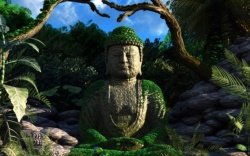Kashyapa Matanga
Kashyapa Matanga
迦葉摩騰 (n.d.) (Skt; Jpn Kasho-mato)
Also known as Matanga. The Indian monk believed to have been the first to introduce Buddhism to China. According to Chinese tradition, he traveled from India to Lo-yang in China with another Indian monk, known by his Chinese name Chu Falan. They came in C.E. 67 at the invitation of Emperor Ming of the Later Han dynasty. Born to a Brahman family in central India, Matanga was well versed in the Hinayana and Mahayana sutras. It is said that Emperor Ming had dreamed about the Buddha and dispatched emissaries to bring his teachings to China. These emissaries invited Matanga and Chu Falan to China, and the two arrived in that country with white horses carrying Buddhist scriptures. Because of this, Buddhism was referred to as the "teaching brought by white horses." The first Buddhist temple in China was built for these two monks in the suburbs of Lo-yang in 67, and was given the name of Pai-ma-ssu (White Horse Temple). At this temple, Matanga and Chu Falan are said to have translated five sutras including the Sutra of Forty-two Sections.
